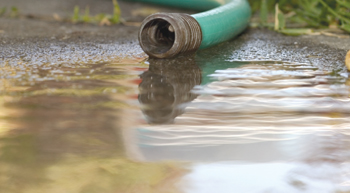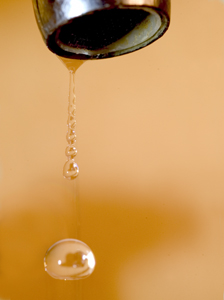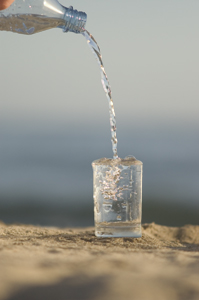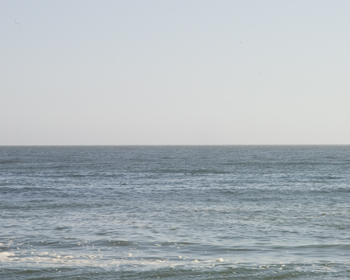![[Metroactive Features]](http://metroactive.com/features/gifs/feat468.gif)
[ Features Index | Santa Cruz | Metroactive Home | Archives ]
Hosed: Santa Cruz has been a leader statewide in conservation efforts, but critics fear desalination will water down efficiency awareness.
A Salt on Monterey Bay
Desalination is the Hottest New Thing in water solutions. But underneath the hype is the fact that a proposed plant will cost Santa Cruzans $42 million over the next five years--and may be hazardous to the health of the Monterey Bay. So why is this costly and environmentally unproven system on the fast track?
By Sarah Phelan
The Monterey Beach Resort Hotel has the kind of oceanfront vistas that keep visitors coming back to California's Central Coast year after year. Seated in the hotel's oceanfront conference room, which overlooks the Monterey Bay National Marine Sanctuary, it's easy to let your mind drift as you watch pelicans skim the waves and dolphins slice the water like black-handled knives through butter.
But when the state's top water planners, regulators, scientists and environmentalists recently met in this room, they were looking at the same waters in an entirely different way: namely, as the Central Coast's largest untapped water supply. As they discussed the best way to set up a series of desalination plants within Sanctuary waters, it was more clear than ever that this once-ridiculed solution to California's never-ending water problems is now being fast-tracked, despite serious questions about its viability and possible negative impacts on our much-celebrated but delicately balanced marine ecosystem.
Hot Water Solution
Written off as an expensive joke as recently as a decade ago, desal's star is now on the rise, with no less than nine new plants, including one at Moss Landing and one in Santa Cruz, proposed within the Monterey Bay National Marine Sanctuary--which stretches from Marin to Cambria--alone.
Lest anyone doubt the seriousness of this plan to convert the ocean into drinking water, it's worth noting that in March of this year, state Secretary for Resources Mike Chrisman sent a letter to the California Coastal Commission, in which he stated that "California would be well served to soon have several full-scale desalination plants operating on our coast so we can monitor and learn about their environmental, engineering and economic consequences before they become more necessary a few decades hence."
Implementing a major change in water policy so that you can then learn about its "consequences" may seem like a classic case of putting the cart before the horse. But with marching orders like that, it's little wonder that panelists from the California Coastal Commission, as well as the Monterey Bay National Marine Sanctuary, the National Water Institute, the state Department of Water Resources, the state Department of Health Services, the Regional Water Quality Control Board, the National Oceanic and Atmospheric Administration and the U.S. Bureau of Reclamation spoke about desalination with an air of inevitability and in sometimes glowing terms at the conference, which, in what would be considered by some to be an ironic twist, was titled "Be Smart About Desal."
"It looks like there's a large interest within the Sanctuary. It looks like desalination is inevitable," says Brad Damitz, an environmental policy specialist with the Monterey Bay National Marine Sanctuary. "We have the opportunity to do everything right, but everything is happening very quickly."
Fawzi Karajeh of the Department of Water Resources extols desal as a reliable and drought-proof--if expensive--source of high-quality drinking water.
"We know for a fact that we'll have shortages," he says, "thanks to successive droughts, agricultural to urban transfers, Bay Delta ecosystem restoration and the insistence on the part of Colorado and six other Colorado River Basin states that we go on a 'water diet' and live within our apportionment."
What Price Desal?
Still, the doubts about desal were evident, even at the conference. Confirming through a highly informal show of hands that the crowd was "fairly favorable to desal," UC-Santa Barbara's Robert Wilkinson made it a point to champion conservation as a critical component of California's water solutions.
"It's inexcusable to think about desali-nation when the hotel toilet is running all night," he says.
Also hammering home the conservation message is Jonas Minton, a consultant with the Planning and Conservation League, who volunteers that nine competing proposals in the same sanctuary is "a recipe for disaster," and dismisses the notion that desal is the only answer to the area's water supply problems.
"Desalination may be part of what those in the water supply business call a 'balanced portfolio of options,' but conservation is the No. 1 option and has 10 times as much potential as desalination. We mustn't divert attention away from it," he says.
Minton doesn't mince words spelling out desal's harmful impacts.
"Virtually everything that comes into a desalination plant is killed," he says. "And we don't even know the cumulative impacts. That's scary. And then there's the relationship to growth and land use. Water folks bob and weave, they try to duck the issue as to who is paying for the water, who gets it and who benefits. The truth is that desalination is still the most expensive option and can result in a severe rate shock."
That's exactly what ratepayers may get here in Santa Cruz, where the city's Water Department is still in the environmental review stage of developing a plant that would produce 2.5 million gallons of water per day in drought years and would be used by Soquel Creek Water District in nondrought years--a plan that would cost $42 million, if approved, and is set to lead, together with the $46 million cost of repairing leaking pipes and mains, to rate increases totaling a 124 percent jump by 2009.
The city's Water Department director, Bill Kocher, notes that though 90,000 people are going to have pay for said plan, he expects most won't air their grievances until they are hit with bills showing a 25 percent raise, which could start as early as this month.
"We're happy if people ask questions," says Kocher. "Public input is necessary, but unfortunately, it doesn't often happen like that. Instead, people open up bill and say, 'Good God, what are all these rate increases about?'"
Water and Growth on the Coast
Kocher, the kind of Santa Cruzan who wears a tie every day but commutes to work on a Harley-Davidson, has spent the last 20 years listening to residents voice their fears that increased water supply equals growth, even as they agitate for more conservation.
He's proud to say that Cruzans lead the conservation pack statewide, using only 76 gallons per person a day, compared to state and Central Coast use, which is 130 and 113 gallons, respectively.
"With the help of a $10 million grant, we hope to get that down to 67 gallons per day, which is about what people had during 1977, which was the worst drought we've had on record," said Kocher. "People say, 'But I conserved 30 percent in '77,' to which I say that we learned to conserve since then, so it's harder today to make massive savings, since things like drip irrigation, low-flow toilets and water faucet fixings are already in place."
The plant Kocher would like to see would be operated by Soquel Creek Water District in "nondrought years and probably at half capacity," to give its overpumped underground water basin a rest.
This means that Santa Cruz, which gets most of its water from the San Lorenzo River, but shares an aquifer with Soquel Creek Water District, would only need the plant in "drought years," which Kocher defines as the only "years in which we ask people to curtail their use at all. But we'd still ask people to conserve. We're running so tight that we'll never have the luxury not to conserve."
But with the Coastal Commission saying it favors regional rather then local desal solutions, Kocher believes planners may say no to Santa Cruz's plan to partner with Soquel Creek Water District and yes instead to a larger plant at Moss Landing.
"But I think that wouldn't be as environmentally friendly as a few smaller operations," he said. "A lot of environmentalists want to see cooling systems, like the one at Moss Landing Power Plant, done away with. But they realize that that would be a lot more difficult if you tie in desal with pre-existing infrastructure in power plants. And then there's the fact that if we relied on a regional plant, we'd be piping drinking water through prime agricultural land. I don't know anyone in Santa Cruz who isn't scared to death of that, since you'd be providing a drought-proof source of water through undeveloped land, which is a perfect formula for subdivisions--and you could certainly do a lot more with that land than grow Brussels sprouts."
The Santa Cruz Plan
Meanwhile, the question remains whether Santa Cruz has a suitable desal site.
First, the city looked for a sandy beach on which to locate a "beach well," which is a preferred model for taking in water to be desalinated.
"The only place that comes close to having the proper sand geology is the Main Beach, and the idea of having a desal plant there is beyond absurd," says Kocher.
For now, the city is looking at doing a pilot project off West Cliff, using a pump near Steamer Lane for intake purposes.
As for the salty question of brine disposal, the city has a plant to which it sends secondary sewage, which is virtually salt-free when it empties two miles out into the ocean.
"Pure water is no better than overly salt water from the marine life point of view, so we plan to build a million-gallon tank, so pure water can be stored, then adequately blended with brine," says Kocher.
As for the setting of the actual desal plant building, the West Side's industrial district is one contender. Recently appointed UCSC Chancellor Martin Chemers has offered up two acres at the university-owned Long Marine Lab.
This does not sit well with environmental watchdogs like Save Our Shores' Jane DeLay, who is concerned that plans are being made to locate a desal plant on the West Side on the basis of existing infrastructure alone.
"Just because the infrastructure is pre-existing, doesn't mean it's the most appropriate place," she says. "Which is why I believe that before desal plants are permitted--and I do believe they are part of our future water portfolio--municipalities should be required to make sure all available conservation technology is in place, including reclamation, and permits should require constant maintenance and improvement."
With Santa Cruz's desal EIR due this fall, DeLay warns that there's a difference between what's on paper and what's implementable.
"What actually happens is multi-dimensional, " she says. "Beach wells mitigate the impacts, but if the physical characteristics of the local geology are unstable and eroding, because of sea walls a couple of doors down, it's not going to work. And what about the recreational uses and what's going to be impaired? Will fishing gear tangle? Is it a navigational hazard? Are divers, kayakers, surfers and beach-goers going to be impacted physically and aesthetically? When you do the analysis, a beach well may not be a viable option."
Asked about the suitability of Santa Cruz's geology, Raimondi says, "There are easier and rougher places, but you could do it. The bigger question is where can you do it that will cause the least environmental damage, since there is no desalination plant that causes zero impact on marine life."
Dangers of Desal
Weighing in at the Monterey conference on how desalination would impact marine life was Dr. Pete Raimondi of UCSC's Center for Ocean Health. Drawing on data collected at intake systems such as the Moss Landing Power Plant, Raimondi said desal operations kill everything from fish, sea turtles and sea lions to eggs, larvae and spores.
"If something big hits the intake screen, it's typically deposited into a trash bin and put into a landfill; smaller things go through, but everything that comes in is assumed to die," says Raimondi.
But while he can tell you that 526 million fish larvae and 13.5 million crab larvae are lost annually inside the Morro Bay plant, Raimondi says it's harder to calculate the ecological impact of such plants.
"You can look at lost productivity of females, the adult equivalent loss, or the proportional mortality of total larvae source. Thousands and billions of larvae enter the plant. How many adult fish would these individuals have resulted in? We can't come up with that number," he says. "How fecund would the surviving females have been? We don't know. So, we look at proportional mortality."
Raimondi says 13 percent to 28 percent of the total larvae source was lost at the Moss Landing Power Plant, which is where CalAmerican is proposing to "collocate" a desal plant, meaning the desal addition would use the same energy and intake and outfall infrastructures as the already existing power plant.
Another iffy aspect of desal, some experts say, is the brine discharge, which is water that contains a high concentration of salt.
Several technologies have been developed for getting salt out of seawater worldwide, but all nine proposed plants within the Monterey Bay National Marine Sanctuary plan to use reverse osmosis. Known as RO in desal circles, reverse osmosis forces intake water through a semipermeable membrane, through which salt molecules cannot pass, thereby leaving a discharge known as brine.
Mike Armstrong, general manager of the Marina Water District, which operates the only desal plant on the California coast currently producing drinking water, says brine disposal has been a challenge.
"Someone could make a lot of money if they came up with an environmentally safe way to dispose of brine," he says.
As it happens, the U.S. Bureau of Reclamation already allocates $1 million to $3 million a year to research and develop ways to inject brine into oil fields to bring out more oil and to sell salt-related byproducts--an investment that the Bureau's Michelle Chapman finds a tad ironic.
"Back in the day, brine was wealth, it allowed you to salt food, survive winter; it signaled the start of civilization," says Chapman. "But now we are trying to get rid of it."
Experts say the problem with all that extra salt being discharged into the ocean is that it causes the brine plume, or trail, to sink, which is bad for critters and plants below, and could lead to cities having to do expensive biological monitoring until they can find clever ways to mix the brine with the nonsalty wastewater to make a discharge that more closely resembles seawater.
And then there's the pathogen issue.
"There's technology that can remove a large percentage of the particles found in seawater, but there are some things which are pretty nasty that are smaller than that," says Raimondi.
Where Desal Didn't Work
So are coastal cities that are contemplating desalination in danger of being left with the proverbial albatross around their neck? Bill Ferguson, a water supply planner with the city of Santa Barbara, recalls how his city, facing a drought in 1990, moved ahead with a desal plant as the most cost effective and immediate solution.
The plant, which consisted of a line of trailers and white cylinders next to the freeway, cost $24 million to build, but was turned off shortly after it was completed and never used again, thanks to abundant rainfall since 1991 and aggressive water conservation programs.
"Was it necessary? If it hadn't rained, yes," says Ferguson. "The good thing about desalination is it works, it can be built quickly, with plant components representing only a fraction of the total costs, and with the technology, while still expensive, getting cheaper."
But DeLay worries that there is no consistent environmental message on desalination.
"What are the biological implications? The effect on marine life? The cumulative impacts? In an energy-scarce environment, will we be able to support the additional energy requirement to produce potable water? Is it worth it? What is its impact on global warming?" she asks.
DeLay notes that with desal, "We'll be preparing to drink treated urban and agricultural runoff, sewage and whatever else we dump in the ocean."
Kocher, though, thinks some of these concerns are unnecessarily alarmist.
"I wouldn't want to scare anybody," he says, "but our current water supplies all come from surface water. We don't have membranes in place and we pick the water up just before it goes to the ocean. So what we would be adding in a desal plant goes way beyond the conventional treatment."
Environmentalists also worry about the larger consequences of looking at the entire ocean as a potential water supply.
DeLay recalls how in the early 1980s, "conservation was the mantra, everybody had to cut back, our water bills were affected and there were serious consequences for not shaping up."
"The minute the rains started, it was if we flipped a switch and 'Consume' was the new message," she says. "We have finite sources of water. We need to look at how we use, save and reuse them. We need to develop a water budget and live within our capacity. And when we talk about cumulative impacts, it's not just desal plants, but the pre-existing overexploitation of our resources, habitat destruction, construction and climate changes that should be taken into account."
Kocher notes that the draft EIR will land bang slap in the middle of the run-up to the 2004 election. Though he's not looking forward to the mudslinging that will likely go on around desalination, he says he's essentially "apolitical."
You've got to wonder how any person can remain apolitical in the business of water, which people are already calling Blue Gold. And then there's the fact that one of Kocher's signature jokes revolves around the 20-year-old adage that there are two things you can't take out of water: salt and politics.
"We've found a way to get the salt out of water," says Kocher, "but not the politics."
[ Santa Cruz | Metroactive Central | Archives ]
Copyright © Metro Publishing Inc. Maintained by Boulevards New Media.
For more information about Santa Cruz, visit santacruz.com.
![]()

Photographs by Stephen Laufer

Osmosis Jones: Desalination was written off as a joke as recently as a decade ago, but there are now nine new plants proposed within the Monterey Bay National Sanctuary alone.

There's Money In Them Thar Spills: Nearly half of the planned 124 percent jump in Santa Cruz water-rate hikes over the next five years is slated to go toward a $42 million desal plant that would be used by the city in drought years and by the Soquel Creek Water District in nondrought years.

Super Sucker: Dr. Pete Raimondi of UCSC's Center for Ocean Health says desal operations will kill everything from fish, sea turtles and sea lions to eggs, larvae and spores, though the full impact of the intake process on marine life can't be precisely measured.
For more information: see www.ci.santa-cruz.ca.us/wt/IWP/IWP.pdf, 'City of Santa Cruz, Integrated Water Plan, Final Draft Report'; and on the California Coastal Commission's website, www.coastal.ca.gov, go to Coastal Related Documents: 'Seawater Desalination and the California Coastal Act, March 2004.'
From the June 9-16, 2004 issue of Metro Santa Cruz.